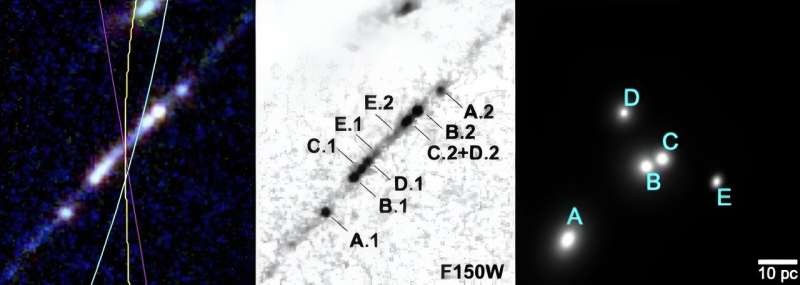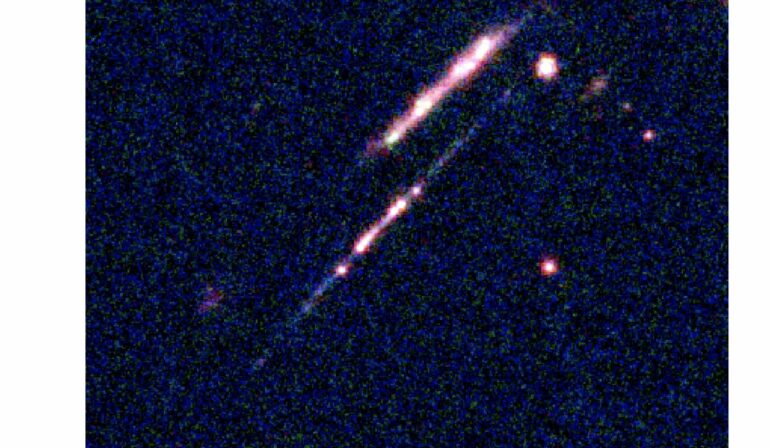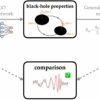An international team of astronomers has used the NASA/ESA/CSA James Webb Space Telescope to discover gravitationally bound star clusters when the universe was 460 million years old. This is the first discovery of star clusters in an infant galaxy less than 500 million years after the Big Bang.
The work is published in the journal Nature.
Young galaxies in the early universe underwent significant burst phases of star formation, generating substantial amounts of ionizing radiation. However, because of their cosmological distances, direct studies of their stellar content have proven challenging. Using Webb, an international team of astronomers has now detected five young massive star clusters in the Cosmic Gems arc (SPT0615-JD1), a strongly-lensed galaxy emitting light when the universe was roughly 460 million years old, looking back across 97% of cosmic time.
The Cosmic Gems arc was initially discovered in NASA/ESA Hubble Space Telescope images obtained by the RELICS (Reionization Lensing Cluster Survey) program of the lensing galaxy cluster SPT-CL J0615−5746.
“These galaxies are thought to be a prime source of the intense radiation that reionized the early universe,” said lead author Angela Adamo of Stockholm University and the Oskar Klein Centre in Sweden. “What is special about the Cosmic Gems arc is that thanks to gravitational lensing, we can actually resolve the galaxy down to parsec scales.”
With Webb, the science team can now see where stars formed and how they are distributed, in a similar way to how the Hubble Space Telescope is used to study local galaxies. Webb’s view provides a unique opportunity to study star formation and the inner workings of infant galaxies at such an unprecedented distance.
“Webb’s incredible sensitivity and angular resolution at near-infrared wavelengths, combined with gravitational lensing provided by the massive foreground galaxy cluster, enabled this discovery,” explained Larry Bradley of the Space Telescope Science Institute and PI of the Webb observing program that captured this data. “No other telescope could have made this discovery.”
“The surprise and astonishment was incredible when we opened the Webb images for the first time,” added Adamo. “We saw a little chain of bright dots, mirrored from one side to the other—these cosmic gems are star clusters. Without Webb we would not have known we were looking at star clusters in such a young galaxy.”
In our Milky Way, we see ancient globular clusters of stars, which are bound by gravity and have survived for billions of years. These are old relics of intense star formation in the early universe, but it is not well understood where and when these clusters formed. The detection of massive young star clusters in the Cosmic Gems arc provides us with an excellent view of the early stages of a process that may go on to form globular clusters.

A zoom-in on the mirrored star clusters in the Cosmic Gems arc. Middle: a negative version of the star clusters, where the different star clusters are marked. Right: the star clusters “behind” the gravitational lens. This image was calculated using computer simulations. © ESA/Webb, NASA & CSA, L. Bradley (STScI), A. Adamo (Stockholm University) and the Cosmic Spring collaboration.
The newly detected clusters in the arc are massive, dense and located in a very small region of their galaxy, but they also contribute the majority of the ultraviolet light coming from their host galaxy. The clusters are significantly denser than nearby star clusters. This discovery will help scientists to better understand how infant galaxies formed their stars and where globular clusters formed.
The team notes that this discovery connects a variety of scientific fields.
“These results provide direct evidence that indicates proto-globular clusters formed in faint galaxies during the reionization era, which contributes to our understanding of how these galaxies have succeeded in reionizing the universe,” explained Adamo.
“This discovery also places important constraints on the formation of globular clusters and their initial properties. For instance, the high stellar densities found in the clusters provide us with the first indication of the processes taking place in their interiors, giving new insights into the possible formation of very massive stars and black hole seeds, which are both important for galaxy evolution.”
In the future, the team hopes to build a sample of galaxies for which similar resolutions can be achieved.
![A field of galaxies on the black background of space. In the middle is a collection of dozens of yellowish galaxies that form a foreground galaxy cluster. Among them are distorted linear features, which mostly appear to follow invisible concentric circles curving around the center of the image. The linear features are created when the light of a background galaxy is bent and magnified through gravitational lensing. A variety of brightly colored, red and blue galaxies of various shapes are scattered across the image, making it feel densely populated.] © ESA/Webb, NASA & CSA, L. Bradley (STScI), A. Adamo (Stockholm University) and the Cosmic Spring collaboration Webb Space Telescope captures star clusters in Cosmic Gems arc](https://techandsciencepost.com/wp-content/uploads/2024/06/1719285608_206_Webb-Space-Telescope-captures-star-clusters-in-Cosmic-Gems-arc.jpg)
A field of galaxies on the black background of space. In the middle is a collection of dozens of yellowish galaxies that form a foreground galaxy cluster. Among them are distorted linear features, which mostly appear to follow invisible concentric circles curving around the center of the image. The linear features are created when the light of a background galaxy is bent and magnified through gravitational lensing. A variety of brightly colored, red and blue galaxies of various shapes are scattered across the image, making it feel densely populated.] © ESA/Webb, NASA & CSA, L. Bradley (STScI), A. Adamo (Stockholm University) and the Cosmic Spring collaboration
“I am confident there are other systems like this waiting to be uncovered in the early universe, enabling us to further our understanding of early galaxies,” said Eros Vanzella from the INAF-Astrophysics and Space Science Observatory of Bologna (OAS), Italy, one of the main contributors to the work.
In the meantime, the team is preparing for further observations and spectroscopy with Webb.
“We plan to study this galaxy with Webb’s NIRSpec and MIRI instruments in Cycle 3,” added Bradley. “The NIRSpec observations will allow us to confirm the redshift of the galaxy and to study the ultraviolet emission of the star clusters, which will be used to study their physical properties in more detail. The MIRI observations will allow us to study the properties of ionized gas. The spectroscopic observations will also allow us to spatially map the star formation rate.”
More information:
Angela Adamo et al, Bound star clusters observed in a lensed galaxy 460 Myr after the Big Bang, Nature (2024). DOI: 10.1038/s41586-024-07703-7. www.nature.com/articles/s41586-024-07703-7
Provided by
European Space Agency
Citation:
Webb Space Telescope captures star clusters in Cosmic Gems arc (2024, June 24)



